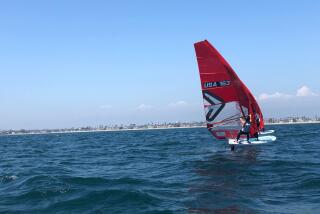Solo Around-the-World Race : Top American Boat Collides at the Start, May Be Out of Race
- Share via
NEWPORT, R.I. — American hopes of winning the solo around-the-world sailing race were dealt a severe blow Saturday when Thursday’s Child was forced to withdraw after a collision at the start of the race. The boat’s rudder was smashed and the steering cables were severly damaged.
Thursday’s Child, skippered by Warren Luhrs, 41, of Alachua, Fla., was hit in the stern by another competitor, Ecureuil d’Aquataine, of France. The 12-ton French boat, traveling at more than eight knots, hit the American’s stern while apparently trying to avoid a spectator boat in the harbor.
Luhrs said he was not going to protest the French boat that hit him, saying the crowded conditions at the start line was the cause of the accident.
Instead, he’s asking the race committee to allow him time to fix the boat and start the race without a time penalty. The race committee will study videotapes of the collision before making a decision.
Thursday’s Child was considered by most as the favorite. It had already beaten Tuna Marine, its rival in two prior ocean races.
In all, 25 boats from 10 nations were towed to the start line for the second running of the race, called the BOC Challenge-Around-Alone.
No sooner had the impact between the American and the French boat occurred, than Tuna Marine, a South African entry sailed by John Martin, 31 of Cape Town became entangled with a small sailboat. The small boat’s boom was ripped off and the craft was knocked flat, dumping the five persons aboard into the water. They were rescued, but their boat was a shambles of broken rigging and shredded sails. Martin sustained damage to deck gear but continued on in the race. Luhrs’ troubles were only beginning. While being towed into a boat yard at Middletown, R.I., Thursday’s Child hit a submerged cable which brought the boat to an abrupt halt.
“We simply don’t know what we’ve got,” a spokesman for Luhrs said. “It’s Saturday night and we’re trying to round up a crew to haul the boat and inspect the damage to the keel, if any.
“We might have 24 hours of work on the steering and rudder. But the keel is an unknown. We’ll just have to get the boat out of the water and see.”
Meanwhile, Luhrs’ rival Tuna Marine, took an immediate lead at the start and looked very strong going out Narragansett Bay in a 12-knot southwesterly wind.
Credit Agricole III of France was fifth going out of the bay, but once into Long Island Sound, its skipper, Philippe Jeantot, stopped his boat and was seen working frantically on a jammed sail.
Jeantot, winner of the last race, put the boat back on course and started after the fleet, obviously underpowered with a makeshift sail. In Class II (boats 40 to 50 feet in length), Jacques de Roux of France, aboard Skoiern IV, held a small lead. De Roux is back to attend to unfinished business. He was capsized and sunk in the 1982-83 BOC Challenge. He was rescued by another skipper in the Southern Ocean.
Another sailor who is determined to make a better showing this time is Richard McBride of New Zealand. His boat went aground on East Falkland Island in 1983. Now he is back with a Class I boat, the 60-foot Neptune’s Express. Going to sea, he was second, hard on the stern of Tuna Marine.
The boats are headed for Cape Town, the first stop in their around-the-world odyssey. They will sail from there to Sydney, then to Rio de Janeiro before returning to Newport early next May.
The French dominate Class I (50-to-60-foot boats). In all, there are six French entered, although the United States, with eight, has the largest number entered.
Other countries represented are Great Britain, Australia, Finland, Brazil, Canada, Japan, New Zealand and South Africa.
Tuna Marine, the former Voortrekker II, is owned by the South African Navy. Martin, its skipper, is a Navy lieutenant commander, although he declined to confirm that when interviewed. “Just call me a sailor,” he said.
Unlike the other entrants that flew their national flags while in port, Tuna Marine did not hoist the South African colors until it was being towed to the start line.
The first boat is expected to reach Cape Town in 40 to 43 days, somewhat faster than Philippe Jeantot’s time of 47 days in the first race.
More to Read
Sign up for Essential California
The most important California stories and recommendations in your inbox every morning.
You may occasionally receive promotional content from the Los Angeles Times.













